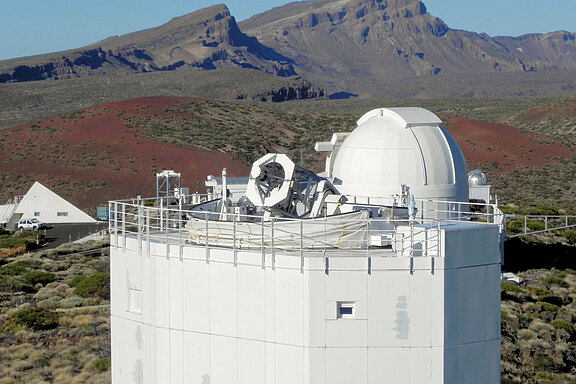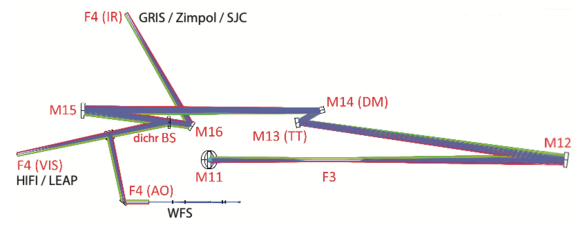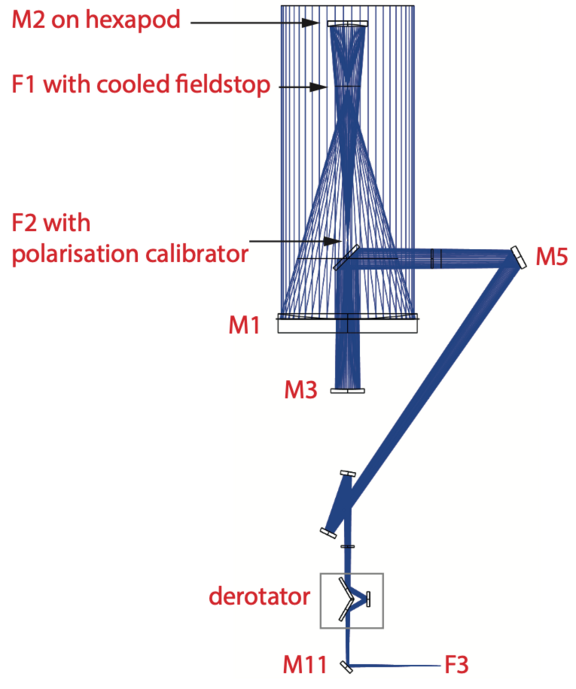
Gregor with a 1.5 m apertur is Europe's largest solar telescope. Gregor provides high-resolution imaging and spectro-polarimetric diagnostics of small-scale magnetic fields in the solar photosphere and chromosphere. Gregor is located at the Observatorio del Teide on Tenerife, Canary Islands. Thanks to its multi-wavelength capability, spectral lines forming at different heights in the solar atmosphere can be observed simultaneously. This enables exploration of the coupling between the solar interior and the corona via magnetic fields.
The solar telescope GREGOR was built by a German consortium consisting of Institute of Solar Physics (KIS), Leibniz Institute for Astrophysics Potsdam (AIP) and Max Planck Society represented by the Max Planck Institute for Solar System Research (MPS) in Göttingen. One of the most important scientific instruments is contributed by the Instituto de Astrofisica de Canarias (IAC). GREGOR has been in scientific operation since 2013.
Optical Layout of Gregor
GREGOR is mounted on an alt-azimuth platform, enabling precise solar tracking across the sky. The telescope uses a double-Gregory configuration, incorporating two focal planes and three imaging mirrors arranged in an axisymmetric layout. A fourth mirror (M4) redirects the beam out of the elevation axis, initiating a series of flat mirrors that guide the light to the instrument room.
At the first focal plane (F1)—located after the primary mirror with a focal length of 2.5 m—an image of the full solar disk is formed, approximately 25 mm in diameter, carrying an optical power of roughly 2000 W. A water-cooled, mirrored field stop is positioned here to select a 2.5 arcminute field-of-view. The remaining portion of the solar disk is reflected back into the sky to prevent stray light contamination downstream.
The elliptical secondary mirror (M2) forms a second image at the second focal plane (F2), which lies within the axisymmetric section of the telescope. This focal plane hosts a retractable polarimetric calibration unit, which is essential for modeling the telescope's instrumental polarization and accurately determining the solar-origin polarization signals.
A third imaging mirror (M3) re-images F2 into F3, located in the telescope’s Coudé instrument lab. The beam is routed via a train of flat mirrors: First into the elevation axis using M4, and then through the azimuth axis via M5, M6, and M7. The mirrors M8–M10 form an image derotator, allowing to control the image rotation relative to the spectrograph slit. After derotation, the beam is reflected by M11 into the horizontal plane of the Coudé laboratory.
Adaptive Optics and Light Distribution in Coudé Lab

In the Coudé lab, relay optics re-image the telescope’s pupil onto the Deformable Mirror (M14), using M12. The Wavefront Sensor (WFS) provides a correction signal that is separated into tip/tilt (handled by M13) and higher-order aberrations (corrected by M14).
The beam is subsequently focused by M15, forming the fourth focal plane (F4). At this point, dichroic beam splitters divide the light into visible and infrared components, directing them to the appropriate scientific instruments. A small fraction of the visible light is diverted to the Wavefront Sensor for real-time atmospheric correction.
